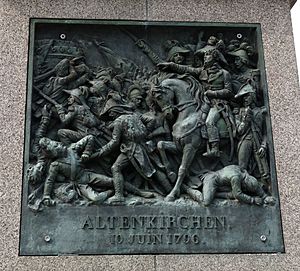Battle of Altenkirchen facts for kids
Quick facts for kids Battle of Altenkirchen |
|||||||
|---|---|---|---|---|---|---|---|
| Part of War of the First Coalition | |||||||
 Detail of a monument to Jean Baptiste Kléber at the Place Kléber, Strasbourg |
|||||||
|
|||||||
| Belligerents | |||||||
| Commanders and leaders | |||||||
| Units involved | |||||||
| Strength | |||||||
| 20,000 | 20,000 | ||||||
| Casualties and losses | |||||||
| light | 1,500, 12 guns | ||||||
The Battle of Altenkirchen happened on 4 June 1796. It was a fight between two armies during the Wars of the French Revolution. French soldiers, led by General Jean Baptiste Kléber, attacked an Austrian army. The Austrians were commanded by Duke Ferdinand Frederick Augustus of Württemberg.
The French won this battle. They used a smart plan, attacking from the front and also from the side. This forced the Austrian army to retreat. Several important French military leaders, who later became famous, took part in this battle. These included François Joseph Lefebvre, Jean-de-Dieu Soult, and Michel Ney.
Altenkirchen is a town in Germany. It is located in the region of Rhineland-Palatinate, about 50 kilometers (31 miles) east of Bonn.
Contents
What Was the War of the First Coalition?
The Battle of Altenkirchen was part of a bigger conflict called the War of the First Coalition. This war was fought between 1792 and 1797. It involved several European powers, like Austria, fighting against the new French Republic. These wars started after the French Revolution. European kings and emperors were worried about the revolution spreading to their own countries.
How Did the Battle Start?
The battle was part of a larger plan by the French army in 1796. This plan was called the Rhine Campaign of 1796. The French wanted to push into Germany.
- General Kléber was ordered to attack south from a French base near Düsseldorf. This base was on the east side of the Rhine River.
- His goal was to create enough space for another French army, led by Jean Baptiste Jourdan, to join him.
- This first attack was actually a trick! The French hoped that the Austrian commander, Archduke Charles, Duke of Teschen, would move his troops north to stop Kléber and Jourdan.
- If the Austrians moved north, it would leave the south open. Then, another French army, led by Jean Victor Marie Moreau, could cross the Rhine River much further south.
The Battle Unfolds
General Kléber did his part of the plan perfectly. His attack at Altenkirchen was successful.
- The French army had about 20,000 soldiers. The Austrian army also had about 20,000 soldiers.
- The French launched a direct attack on the Austrian lines.
- At the same time, a part of the French army moved around the side of the Austrian forces. This is called a "flanking maneuver."
- This double attack was too much for the Austrians. They were forced to pull back.
- The Austrians lost about 1,500 soldiers and 12 cannons. The French had only light losses.
What Happened Next?
Kléber's victory at Altenkirchen helped the overall French plan.
- Because Kléber had pushed the Austrians back, General Jourdan was able to cross the Rhine River at Neuwied on 10 June.
- This set the stage for the next major battle in the campaign, the Battle of Wetzlar, which happened a few days later on 15–16 June.
The Battle of Altenkirchen was an important early victory for the French in the 1796 campaign. It showed the skill of their generals and helped them advance their larger strategy.

